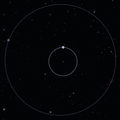Kerbin/ko
커빈(Kerbin)은 현실의 지구와 대응되고 커발들의 모행성이며 우주 센터가 있는 행성이고 커발 스페이스 프로그램의 중심이기도 합니다. 커빈은 문과민무스라는 이름의 위성을 가지고 있습니다.
커빈은 커볼의 샛째행성이다. 또한 쥴과 이브다음으로 큰 행성 이고 커볼 주위의 물체중 4번째로 큽니다(쥴의 위성인 타일로가 커빈보다 약간 더 커서 4번째로 밀려남).
Reaching a stable orbit around Kerbin is one of the first milestones a player might achieve in the game. Achieving such an orbit with a fuel-optimal ascent[1] requires a delta-V of ≈4500 m/s,[2] the second largest of all celestial bodies with a solid surface after Eve. For many interplanetary missions, this represents over half of the flight's total delta-V requirement. This is also true of Earth-based interplanetary spaceflights, leading one observer to remark that:
| “ | If you can get your ship into orbit, you're halfway to anywhere. — Robert Heinlein, quoted on page 194 of A Step Farther Out by Jerry Pournelle |
” |
Contents
Topography
Kerbin has a roughly equal distribution of surface liquid water and solid land, with polar icecaps and scattered deserts. There are mountains exceeding 4 km in height, with the tallest peak being just under 4044 m in altitude.
Kerbin shows signs of having been impacted by an asteroid or comet. That is visible in the large crater in the western hemisphere. The crater's central peak is visible from orbit and was caused by the compression followed by the rebound of material in the center of the crater.
Atmosphere
Kerbin's atmosphere contains oxygen and extends to roughly 69,078 meters. Its atmosphere becomes exponentially less dense as altitude increases (with a scale height of 5 km).[3] In general, the atmospheric pressure on Kerbin, at an altitude expressed in meters, is:
The thickness of Kerbin's atmosphere makes it suitable for aerobraking and using parachutes, useful for saving on fuel when spacecraft return to Kerbin. Note that debris is not affected by air resistance above approximately 10 km, so spent stages may continue in a stable orbit even if they are going through thick atmosphere that would stop an active craft (0.19). Crafts will experience re entry and supersonic air effects as of 0.19. This however will not damage or burn it.
The following table gives approximation of terminal velocities at different Kerbin altitudes. These are also the velocities at which a ship should travel for a fuel-optimal ascent from Kerbin, given the game's model of atmospheric drag.[4]
| Altitude (m) | Velocity (m/s) |
|---|---|
| 0 | 97.3 |
| 1000 | 110 |
| 3000 | 130 |
| 5000 | 160 |
| 8000 | 215 |
| 10000 | 260 |
| 15000 | 425 |
| 32000 | 2250 |
Orbits
Geosynchronous orbit is achieved at an altitude of 0.00 미터 and a speed of Expression error: Unexpected < operator. m/s. From a 70 km low equatorial orbit, the periapsis maneuver requires 676.5 m/s and the apoapsis maneuver requires 434.9 m/s. A semi-synchronous orbit with an orbital period of 1/2 of Kerbin's rotation period (3 hours or 10800 seconds) is achieved at an altitude of 0.00 미터 with an orbital velocity of Expression error: Unexpected < operator. m/s.
The Hill Sphere (the radius around the planet at which moons are gravitationally stable) of Kerbin is 136 185km, or roughly 227 Kerbin radii.
Interplanetary Travel
From the lowest stable orbit around Kerbin (70 km), the amount of delta-V needed to reach the orbits of other celestials is as follows:
| Body | Delta-V | |
|---|---|---|
| Mün | ~860 m/s | |
| Minmus | ~930 m/s | |
| Eve | ~1033 m/s | |
| Duna | ~1060 m/s | |
| Moho | ~1676 m/s | |
| Jool | ~1915 m/s | |
| Eeloo | ~2100 m/s | |
| KEO (comparison) | ~1120 m/s | |
Reference Frames
| 시간 배속 | 최저 고도 |
|---|---|
| 1× | 어디서든지 |
| 5× | 70 000 미터 (대기 바깥에서) |
| 10× | 70 000 미터 (대기 바깥에서) |
| 50× | 70 000 미터 (대기 바깥에서) |
| 100× | 120 000 미터 |
| 1 000× | 240 000 미터 |
| 10 000× | 480 000 미터 |
| 100 000× | 600 000 미터 |
Gallery
- NJ6qJ.jpg
A projection map of Kerbin, as of 0.14.1 and before (including the old demo).
Topographical image of Kerbin from 0.17.1. The terrain is slightly different in the latest version.[5]
Changes
- Fixed ladders on the fuel tanks near the launchpad.
- New mesh for the launchpad and area (no launchtower anymore).
- New mesh for the runway, with lights and sloping edges for rovers.
- Terrain overhaul: Entire planet redo. Deserts, darker and greener grass, islands, darker ocean/water, snow capped mountains. Looks more realistic.
- Several Easter Eggs added.
- 공항이 KSC 앞 바다 섬에 추가됨
- Improved atmosphere visuals.
- Minmus added.
- Much more varied and taller terrain added. Prior to this, some mountain ranges exceeded 600 m in height, but the tallest point was at an altitude of approximately 900 m.
- 문이 추가됨.
- Terrain overhaul, oceans became wet.
- 대기가 34,500m 에서 69,000m로 확장됨.
- 최초 릴리즈
Trivia
Kerbin's continents are derived from libnoise [6], though they have been increasingly modified with time.
Notes
- ↑ A fuel-optimal ascent is one which (a) minimizes velocity losses to gravity and atmospheric drag and (b) launches eastward (toward the 90 degree heading) to gain 174.5 m/s of orbital velocity for free, thanks to Kerbin's rotation.
- ↑ See this challenge on the forum and a popular Kerbin delta-V chart
- ↑ Forum thread 16000, "[KGSS] Examining Kerbin's atmosphere"
- ↑ http://forum.kerbalspaceprogram.com/showthread.php/6664-Mini-challenge-max-altitude-with-this-supplied-spacecraft?p=100912&viewfull=1#post100912
- ↑ http://forum.kerbalspaceprogram.com/entry.php/247-A-Brave-New-World
- ↑ http://libnoise.sourceforge.net/examples/complexplanet/











